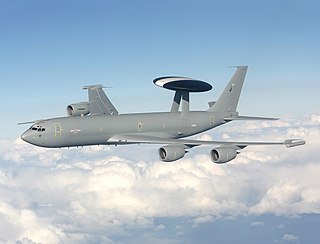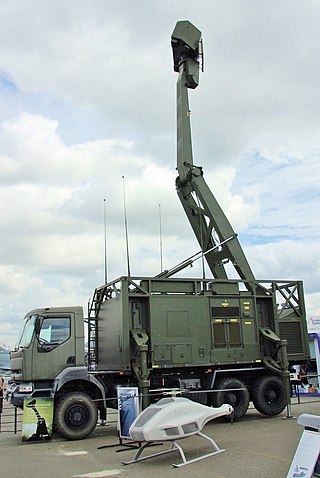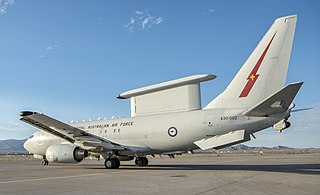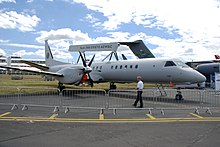
The Boeing E-3 Sentry is an American airborne early warning and control (AEW&C) aircraft developed by Boeing. E-3s are commonly known as AWACS. Derived from the Boeing 707 airliner, it provides all-weather surveillance, command, control, and communications, and is used by the United States Air Force, NATO, French Air and Space Force, Royal Saudi Air Force and Chilean Air Force. The E-3 has a distinctive rotating radar dome (rotodome) above the fuselage. Production ended in 1992 after 68 aircraft had been built.

Saab AB, with subsidiaries collectively known as the Saab Group, is a Swedish aerospace and defense company primarily operating from Sweden. The company is headquartered in Stockholm, but its development and manufacturing operations are undertaken in Linköping.

An airborne early warning and control (AEW&C) system is an airborne radar early warning system designed to detect aircraft, ships, vehicles, missiles and other incoming projectiles at long ranges, as well as performing command and control of the battlespace in aerial engagements by informing and directing friendly fighter and attack aircraft. AEW&C units are also used to carry out aerial surveillance over ground and maritime targets, and frequently perform battle management command and control (BMC2). When used at altitude, the radar system on AEW&C aircraft allows the operators to detect, track and prioritize targets and identify friendly aircraft from hostile ones in real-time and from much farther away than ground-based radars. Like ground-based radars, AEW&C systems can be detected and targeted by opposing forces, but due to aircraft mobility and extended sensor range, they are much less vulnerable to counter-attacks than ground systems.

The Saab 2000 is a twin-engined high-speed turboprop airliner built by Swedish aircraft manufacturer Saab. It is designed to carry 50–58 passengers and able to cruise at a maximum speed of 685 km/h (370 kn). Production took place in Linköping, Sweden. The Saab 2000 first flew in March 1992 and was certified in 1994. The last aircraft was delivered in April 1999, a total of 63 aircraft being built. As of June 2023, 31 total Saab 2000s were in either airline or military service.

The Saab 340 is a Swedish twin-engine turboprop aircraft designed and initially produced by Saab AB and Fairchild Aircraft. It is designed to seat 30-36 passengers and, as of July 2018, there were 240 operational aircraft used by 34 different operators.

The Boeing E-7 Wedgetail is a twin-engine airborne early warning and control aircraft based on the Boeing 737 Next Generation design. It has a fixed, active electronically scanned array radar antenna instead of a rotating one as with the 707-based Boeing E-3 Sentry. The E-7 was designed for the Royal Australian Air Force (RAAF) under "Project Wedgetail" and designated E-7A Wedgetail.

An active electronically scanned array (AESA) is a type of phased array antenna, which is a computer-controlled antenna array in which the beam of radio waves can be electronically steered to point in different directions without moving the antenna. In the AESA, each antenna element is connected to a small solid-state transmit/receive module (TRM) under the control of a computer, which performs the functions of a transmitter and/or receiver for the antenna. This contrasts with a passive electronically scanned array (PESA), in which all the antenna elements are connected to a single transmitter and/or receiver through phase shifters under the control of the computer. AESA's main use is in radar, and these are known as active phased array radar (APAR).

The Embraer R-99 is the Brazilian Air Force (FAB) military designation of the EMB-145-RS. Various models of the aircraft have been produced to perform special mission duties, including the E99 for airborne early warning and control (AEW&C) missions, the R-99 for remote sensing, and the P-99 for maritime patrol.

The Bombardier Global Express is a large cabin, long-range business jet designed and manufactured by Bombardier Aviation. Announced in October 1991, it first flew in October 1996, received its Canadian type certification in July 1998 and entered service in July 1999. Initially powered by two BMW/Rolls-Royce BR710s, it shares its fuselage cross section with the Canadair Regional Jet and Challenger 600 with a new wing and tail.

The Saab Giraffe Radar is a family of land and naval two- or three-dimensional G/H-band passive electronically scanned array radar-based surveillance and air defense command and control systems. It is tailored for operations with medium- and Short Range Air Defense (SHORAD) missile or gun systems, or for use as gap-fillers in a larger air defense system.

The KJ-2000 is a Chinese second-generation airborne early warning and control (AEW&C) aircraft developed by the Shaanxi Aircraft Corporation, and is the first AEW&C system in service to the People's Liberation Army Air Force. It is built upon a modified Russian Ilyushin Il-76 airframe using domestically designed avionics and a fixed radome featuring three active electronically scanned array (AESA) radars each covering a 120-degree sector, unlike the rotating radome on the comparable E-3 Sentry serving the United States Air Force.
The Centre for Airborne Systems (CABS) is a laboratory of the Defence Research and Development Organisation (DRDO) of India. Located in Bengaluru, its primary function is development and evaluation of airborne electronic systems for military applications.
The Airborne Surveillance Platform (ASP) is an Indian defence project initiated by the Defence Research and Development Organisation (DRDO) with the aim to produce an Airborne Early Warning System. Two prototypes were developed and flight tested for three years. The project was cancelled in 1999 after the prototype aircraft crashed, killing eight scientists and the aircrew. After four years of inactivity, the project was revived in 2004 with a new platform and radar.
Electronics and Radar Development Establishment (LRDE) is a laboratory of the Defence Research & Development Organisation (DRDO), India. Located in C.V. Raman Nagar, Bengaluru, Karnataka, its primary function is research and development of radars and related technologies. It was founded by S. P. Chakravarti, the father of Electronics and Telecommunication engineering in India, who also founded DLRL and DRDL.

The DRDO Airborne Early Warning and Control System (AEW&CS) is a project of India's Defence Research and Development Organisation to develop an airborne early warning and control system for the Indian Air Force. It is also referred to as NETRA Airborne Early Warning and Control System (AEW&CS).

The Saab 340 AEW&C is a Swedish airborne early warning and control (AEW&C) aircraft. A variant of the Saab 340 aircraft is designated S 100B Argus by the Swedish Air Force.

The EL/W-2085 is an airborne early warning and control (AEW&C) multi-band radar system developed by Israel Aerospace Industries (IAI) and Elta Electronics Industries of Israel. Its primary objective is to provide intelligence to maintain air superiority and conduct surveillance. The system is currently in-service with Israel, Italy, and Singapore.

GlobalEye is a multi-role airborne early warning & control (AEW&C) platform from Swedish defence and security company Saab. GlobalEye consists of a suite of sensors using Saab's Erieye ER radar and mission system, installed in the Bombardier Global 6000/6500 long-range business jet.

The Multi-role Electronically Scanned Array (MESA) is an active electronically scanned array surveillance radar system for the Boeing E-7 Wedgetail airborne early warning and control aircraft. The radar is produced by Northrop Grumman.





















